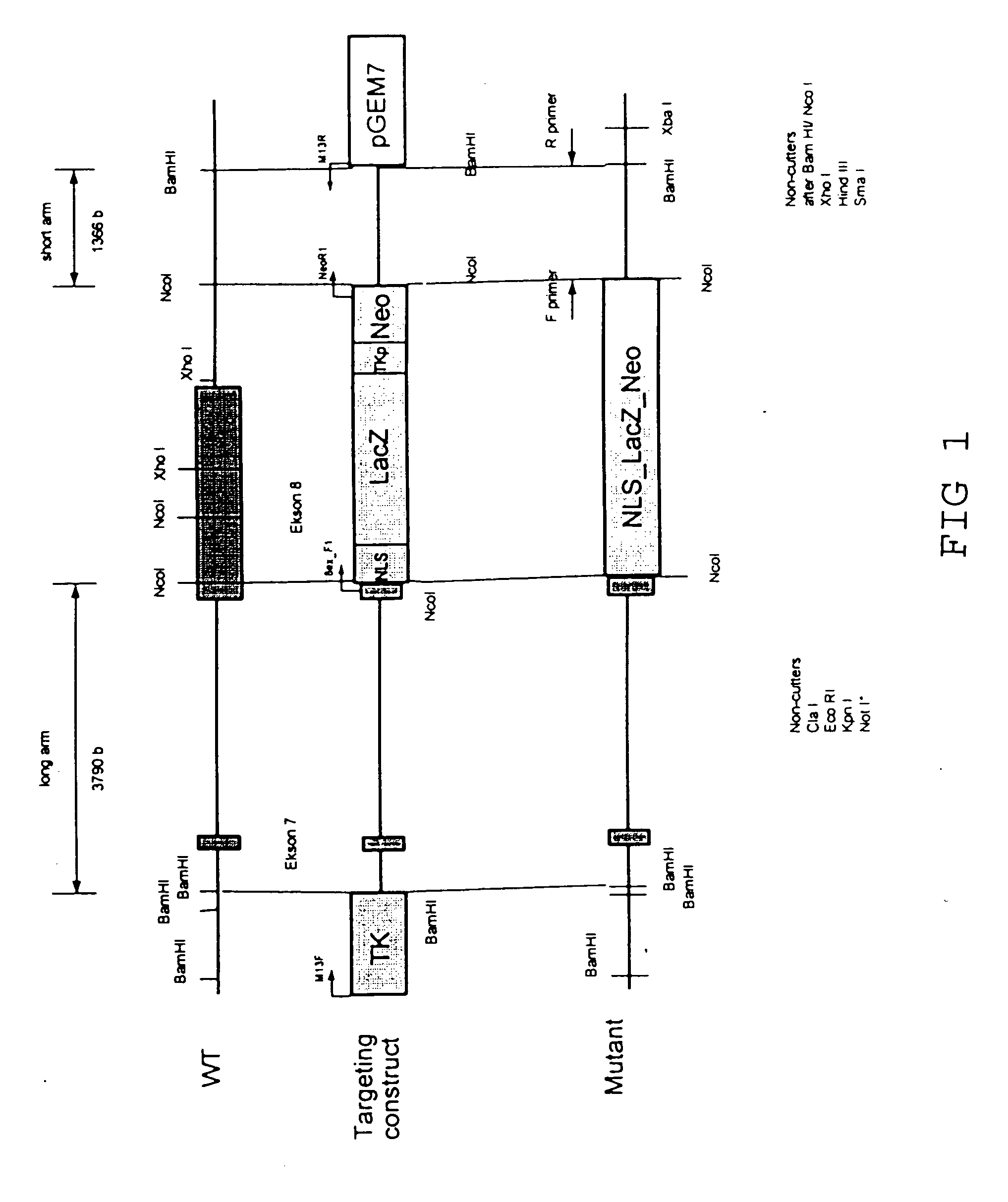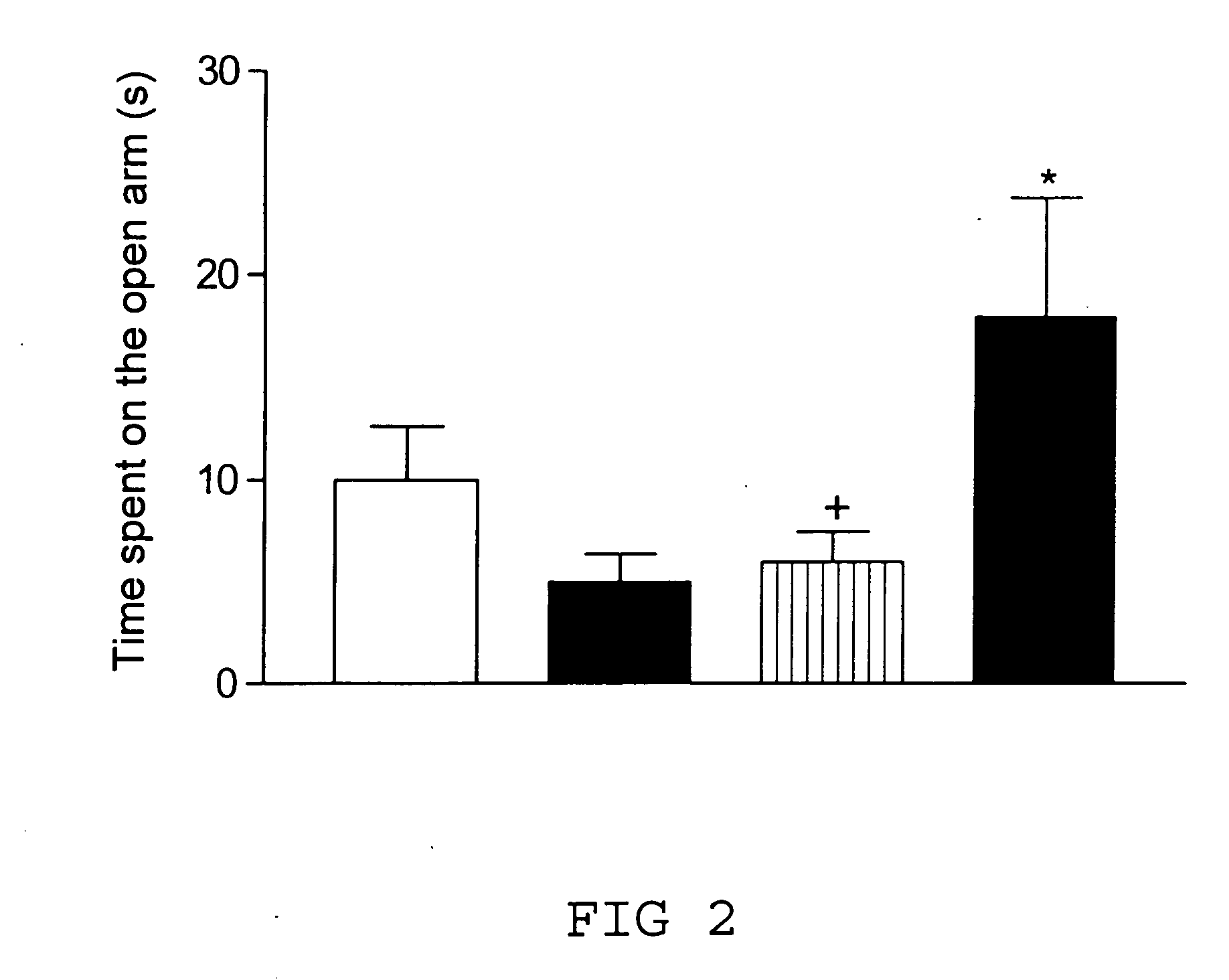Transgenic animal model for modelling pathological anxiety, a method for identifying compounds for treatment of diseases or disorders caused by pathological anxiety and a method for using wfs1 protein as a target for identifying effective compounds against pathological anxiety
a transgenic animal and model technology, applied in the field of molecular biology, can solve the problems of pathological anxiety, high treatment cost, and long anxiety state, and achieve the effects of reducing environmental changes, increasing anxiety, and increasing anxiolytic action
- Summary
- Abstract
- Description
- Claims
- Application Information
AI Technical Summary
Benefits of technology
Problems solved by technology
Method used
Image
Examples
example 1
Creating a Transgenic Animal Model for Pathological Anxiety
[0044]The ordinarily skilled artisan recognizes that there are a number of basic strategies for creating a rodent with nonfunctional Wfs1 protein. In a preferred embodiment a mutation is introduced into the wild-type Wfs1 gene of a rodent so that it renders the Wfs1 protein nonfunctional. In a preferred embodiment this is done by cloning a DNA targeting construct that comprises a mutation (point mutation, deletion, insertion) flanked (e.g. surrounded) by sequences of desired length of the wildtype Wfs1 gene allele to permit homologous recombination (FIG. 1). In preferred embodiments, the rodent is the mouse as mouse is the only mammal where homologous recombination with efficient germline transmission is currently available. An exemplary procedure used in the present invention to generate a transgenic mouse line expressing nonfunctional Wfs1 protein and having a NLS-LacZ marker protein fused to the truncated form of Wfs1 pol...
example 2
Animal Models for Pathological Anxiety
[0046]In order to describe some possible applications of the object of the invention, we performed several behavioural experiments. Anxiety markers were assessed or animal behaviour was scored in the experiments.
[0047]Anxiety Tests.
[0048]Ethological models based on inborn anxiety reactions.
[0049]Elevated Plus-Maze
[0050]The plus cage consisted of two reciprocally positioned closed (surrounded by walls) and open arms, resembling a plus sign in shape. The cage was elevated to the height of 30 cm. The principle of the model consists in the tendency of anxious animals to avoid entering the open arms of the cage and to prefer to stay in the closed arms. The experiment was performed with preceding isolation (15-20 min) of the animals from their cage fellows. Lighting level during the experiment was 12-20 lux. The experiments revealed that female and male Wfs1 − / − mice behave differently. Namely, female Wfs1 − / − mice exhibit a significant reduction of t...
example 3
Identification of Compounds Suitable for the Treatment of Diseases or Conditions Caused by Pathological Anxiety
[0062]The following example describes one possible mode for using the invention for the identification of compounds suitable for the treatment of diseases or conditions caused by pathological anxiety.
[0063]Two groups of mice with Wfs1 gene deficiency took part in the experiment. Mice in the test group were injected a solution containing a compound or a mixture of compounds in a known concentration. The administration was performed into the abdominal cavity, when the agent was capable to penetrate effectively the haematoencephal barrier (e.g. a low-molecular compound) or into brain ventricles, when the agent (e.g. a peptide or other rapidly metabolized compound) was not able to penetrate it. The mice in the control group were administred physiological saline. After the administration of the agent or physiological saline a behavioural experiment was performed on the animals, ...
PUM
 Login to View More
Login to View More Abstract
Description
Claims
Application Information
 Login to View More
Login to View More - R&D
- Intellectual Property
- Life Sciences
- Materials
- Tech Scout
- Unparalleled Data Quality
- Higher Quality Content
- 60% Fewer Hallucinations
Browse by: Latest US Patents, China's latest patents, Technical Efficacy Thesaurus, Application Domain, Technology Topic, Popular Technical Reports.
© 2025 PatSnap. All rights reserved.Legal|Privacy policy|Modern Slavery Act Transparency Statement|Sitemap|About US| Contact US: help@patsnap.com



